| Learn About Diamond Clarity
|
Clarity
describes the presence or absence of inclusions within the diamond and
blemishes on its surface. |
| |
|
These
slight "birthmarks of nature" make every diamond quite unique. However,
they do affect the beauty and value of the diamond. These natural
birthmarks are often referred to as inclusions. The fewer inclusions a
diamond has the more rare and valuable it is. Diamonds which contain
numerous inclusions are less brilliant because inclusions interfere with
light passing through the diamond.
The GIA
(Gemological Institute of American) clarity grading scale outlined below
is the most widely accepted clarity grading system in the world. GIA’s
clarity grading scale specifies eleven grades:
Flawless (FL),
Internally Flawless (IF),
(VVS1-VVS2), Very, Very Slightly Included
(VS1-VS2), Very Slightly Included
(SI1-SI2), Slightly Included
Imperfect (I1,I2,I3). |
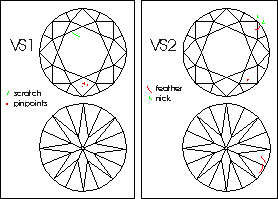 |
| |
|
The GIA
clarity grading system is presented below. The following illustrations
are to be used only as a reference. In terms of appearance, diamonds
present an endless variety of clarity-characteristic combinations, so
there can never be a single description that automatically describes a
given grade.
The
illustrations shown below are actual plots from GIA diamond quality
reports in which GIA assigned a clarity grade. Plots are drawn using
different colors of ink to distinguish between blemishes and inclusions:
red for inclusions,
green for blemishes ,
cavities, naturals, knots and laser drill holes, and black for extra
facets. If you would like to learn more details about how a diamond is
plotted, click the following link: Learn More About Plotting Diamond
Clarity.
GIA
(Gemological Institute of America) and the AGS (American Gem Society)
provide the most accurate certifications and clarity grades. Both GIA
and AGS provide diamond plots that detail every internal and external
characteristic that is visible in a diamond at 10X magnification.
Diamond
certifications from EGL (European Gemological Laboratory), IGI
(International Gemological Institute) and other gemological laboratories
usually plot only the more noticeable internal and external
characteristics. Minor inclusions that are difficult to see may not be
shown on the plot.
GIA
Clarity Grading System:
It is
important to be know that inclusions and blemishes are much more difficult
to see in the actual diamond than they usually appear as drawn on the
diamond plot. |
| |
|
|
FL:
(Flawless) Flawless diamonds show no inclusions or blemishes of any
sort when examined by a skilled grader under 10X binocular magnification
IF:
(Internally Flawless) No inclusions, and only insignificant surface
blemishes. Normally, what separates IF from FL diamonds are
characteristics that can be removed by very minor re-polishing.
|
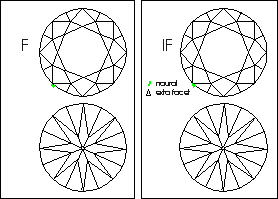 |
| |
|
|
VVS1
and VVS2: (Very Very Slightly Included) Minute inclusions that are
difficult for even a skilled grader to see under 10X binocular
magnification. In VVS1, they are extremely difficult to see, visible only
from the pavilion, or small and shallow enough to be removed easily by
re-polishing. In VVS2, inclusions are still difficult to see.
Typical inclusions: scattered pinpoints, taint clouds, slightly bearded
girdles, internal graining, and tiny feathers, chips and bruises. |
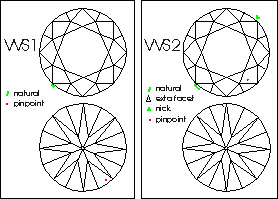 |
| |
|
|
VS1 and
VS2: (Very Slightly Included) Minor inclusions ranging from difficult
to somewhat easy for a trained grader to see when examined using 10X
magnification. Typical Inclusions: small included crystals and
feathers, distinct clouds, and groups of pinpoints. |
 |
| |
|
|
SI1 and
SI2: (Slightly Included) Noticeable inclusions that are easy (SI1) or
very easy (SI2) to see when examined by a trained grader using 10X
magnification. Typical inclusions: small included crystals, clouds,
feathers. |
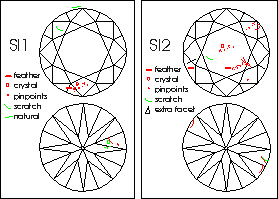 |
| |
|
|
I1,12 and I3: (Imperfect) Obvious inclusions that are often easily
eye-visible face up; in I3 they may threaten durability. Typical
inclusions: large included crystals and feathers. |
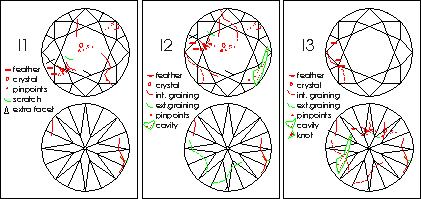 |
|
| |
|
Select
a diamond that is better than eye perfect. The Certified
Gemologist-Appraisers recommend selecting a diamond with a clarity grade
between FL and SI2. Diamonds with a clarity grade of SI2 usually will not
display inclusions to the unaided eye in diamond sizes under one carat.
When selecting a diamond which weighs between one and two carats, it is
best to select a diamond with a clarity grade of SI1 or higher to be sure
no inclusions will be visible to the unaided eye. Diamonds that weigh over
two carats may require selecting a diamond with a clarity grade of VS2,
VS1 or higher.
Is
Clarity Quality less important than Carat Weight, Cut and Color quality?
If your goal is to select the most attractive and brilliant diamond
possible within a specified budget, it is important to consider selecting
a diamond with a better cut quality, larger size or a higher color grade
than it is to select a diamond with a very high clarity grade. For
example: Consider two diamonds that are nearly the same in price. Both
diamonds weigh one carat. One diamond has VS2 clarity grade, very fine cut
and fine white D color The other diamond has a FL (flawless) clarity
grade, average cut and near white H color. Because FL and VS2 clarity
grades appear the same to the unaided eye and differences in cut quality,
color and size are very apparent, the D color VS2 will obviously be the
most beautiful diamond for the price. |
|
Learn About Diamond Clarity
Previous | Next
|
|









